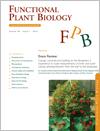
Functional Plant Biology
Volume 39 Number 1 2012
FP11255 Canopy conundrums: building on the Biosphere 2 experience to scale measurements of inner and outer canopy photoprotection from the leaf to the landscape
Leaf to ecosystem scale experiments in the controlled environments of Biosphere 2 stimulated new methods for measurement of canopy photosynthesis. These highlighted different processes responsible for reversible down regulation of inner and outer canopy photosynthetic efficiency in evergreen woody plants that retain dense canopies of old leaves in the shade. Further developments of laser induced fluorescence transient (LIFT) methods for remote sensing of these canopy processes are described.
FP11090 Photosynthetic sensitivity to drought varies among populations of Quercus ilex along a rainfall gradient
Understanding how forest will respond to increasing drought in the long run is crucial in the context of climate change. Comparing leaf photosynthetic limitation to drought in three populations of a wide spread Mediterranean oak differing in water availability for decades; we found that dryer populations were less limited by drought. This result highlights the need for further research on forest acclimation to long term drought and its formulation in forest productivity models.
FP11116 Flowering in snow tussock (Chionochloa spp.) is influenced by temperature and hormonal cues
Snow tussocks exhibit extreme episodic seeding that appears to be triggered by environmental cues. In order to investigate this, we subjected plants to a range of treatments (combinations of warming, root pruning and applications of a plant hormone) and found flowering was causally related to high temperature-induced increases in hormone levels. This could have important implications for regulating the evolutionary interaction between these plants and their seed predators.
FP11171 Response of Aegilops species to drought stress during reproductive stages of development
Drought stress is an important environmental factor limiting productivity of wheat. Genotypes of wild (Aegilops species) and spring wheat were screened under controlled environments and genotypes tolerant to drought stress during flowering were identified. Tolerant genotypes had lesser decline in grain number and grain weight under drought stress and can potentially be utilised to improve drought tolerance in wheat.
FP11178 Development of an assay to evaluate differences in germination rate among chickpea genotypes under limited water content
The paper describes the development and use of an assay to evaluate genotypic differences in germination under low soil water content in chickpea. It consists of small plastic containers (50 mm × 50 mm × 60 mm) filled with river sand and tightly closed (but not sealed) to minimise water loss and maintain constant soil water content during germination. The assay is a suitable experimental tool to examine gene expression in contrasting genotypes during germination and early stages of seedling growth.
FP11165 Generation and scavenging of reactive oxygen species in wheat flag leaves under combined shading and waterlogging stress
Concurrent waterlogging and shading stress (WS) under persistent rainfalls during grain filling stage causes great yield losses in wheat. WS resulted in severe oxidative stress in chloroplasts and leaves which impaired photosynthesis, these effects were regulated at transcription level by modifying the expression of related genes. The results advanced our understanding of the climate change effects on wheat production.
FP11173 Plant growth-promoting bacteria as a tool to improve salinity tolerance in sweet pepper
Plant growth-promoting bacteria alleviate salt-produced stress in pepper plants significantly. A study in which peppers were irrigated with a nutrient solution containing NaCl showed that a rhizosphere bacterium (Azospirillum) – commonly used as a biofertiliser – enhanced plant growth, reduced the harmful Cl– concentration in the leaves and improved N nutrition. The results open new possibilities for the use of low quality waters in agriculture in arid or semi-arid regions, as the use of good quality water faces strong competition from the demand for household and industrial consumption.



